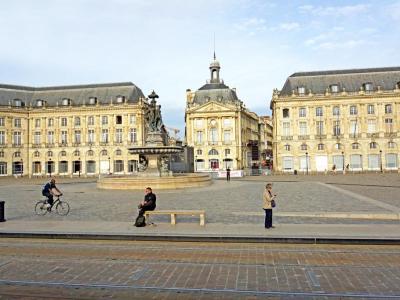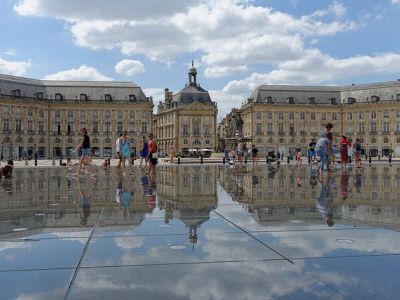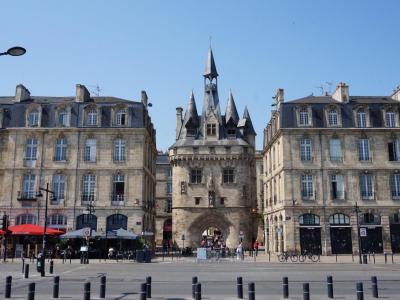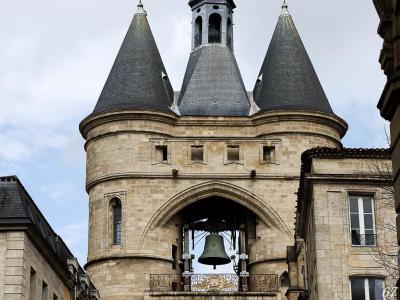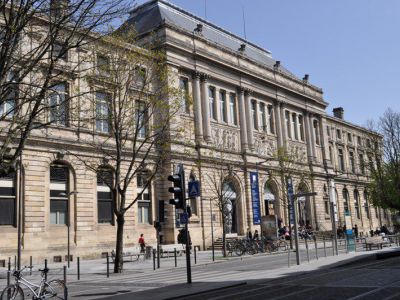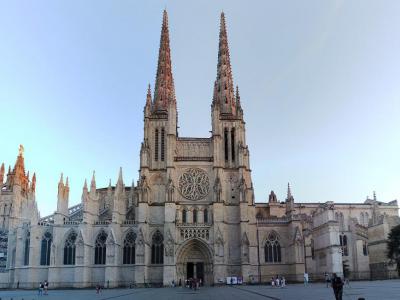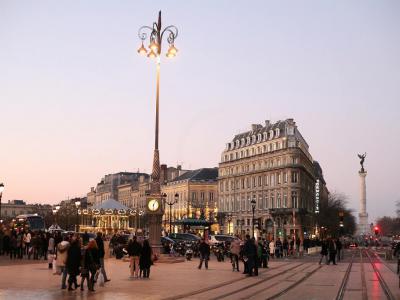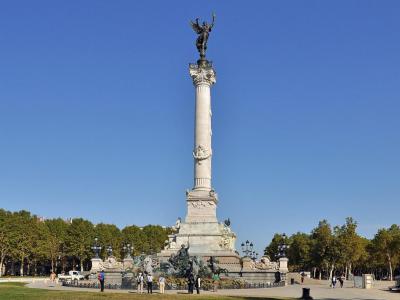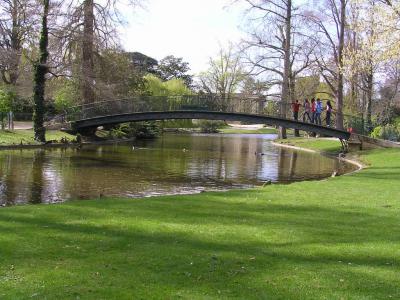
Bordeaux Introduction Walking Tour (Self Guided), Bordeaux
The metropolitan region of Bordeaux is the fifth largest in France. The city is the capital of the Nouvelle-Aquitaine region, but is perhaps better known as the Wine Capital of the World. The city's namesake wine comes in many varieties that can be found and enjoyed around the world.
The name of Bordeaux is a long-standing debate among historians. The first inhabitants of the region were Celtic, who named the area Burdigala. Some argue this stems from the Basque language meaning "swamp shelter." Others think it is from Greek in reference to nearby bodies of water.
Regardless of the origins of the city's name, what is known is that the ruler of Bordeaux has changed many times over the centuries. It was first taken over by Julius Caesar in 56 BC. The city changed hands multiple times, mostly due to the fact that the waterways made food and ware easy to transport to other parts of Europe. At one point, the city was the second busiest port in the world.
Though the city has had its ups and downs, today it is considered an inhabited historic city as much of the central area of Bordeaux has gained UNESCO World Heritage site status. Some of the areas that fall within this list are the Stock Exchange Square and Palace Gate.
Bordeaux is renowned for hosting one the world's largest wine festivals. The Bordeaux Wine Festival is held each summer. It features music, games, food and wine tasting. Visitors can enjoy even more information and wine-based recreation at the City of Wine Museum.
Take this self-guided walking tour to see the beauty, history and culture of Bordeaux.
The name of Bordeaux is a long-standing debate among historians. The first inhabitants of the region were Celtic, who named the area Burdigala. Some argue this stems from the Basque language meaning "swamp shelter." Others think it is from Greek in reference to nearby bodies of water.
Regardless of the origins of the city's name, what is known is that the ruler of Bordeaux has changed many times over the centuries. It was first taken over by Julius Caesar in 56 BC. The city changed hands multiple times, mostly due to the fact that the waterways made food and ware easy to transport to other parts of Europe. At one point, the city was the second busiest port in the world.
Though the city has had its ups and downs, today it is considered an inhabited historic city as much of the central area of Bordeaux has gained UNESCO World Heritage site status. Some of the areas that fall within this list are the Stock Exchange Square and Palace Gate.
Bordeaux is renowned for hosting one the world's largest wine festivals. The Bordeaux Wine Festival is held each summer. It features music, games, food and wine tasting. Visitors can enjoy even more information and wine-based recreation at the City of Wine Museum.
Take this self-guided walking tour to see the beauty, history and culture of Bordeaux.
How it works: Download the app "GPSmyCity: Walks in 1K+ Cities" from Apple App Store or Google Play Store to your mobile phone or tablet. The app turns your mobile device into a personal tour guide and its built-in GPS navigation functions guide you from one tour stop to next. The app works offline, so no data plan is needed when traveling abroad.
Bordeaux Introduction Walking Tour Map
Guide Name: Bordeaux Introduction Walking Tour
Guide Location: France » Bordeaux (See other walking tours in Bordeaux)
Guide Type: Self-guided Walking Tour (Sightseeing)
# of Attractions: 9
Tour Duration: 2 Hour(s)
Travel Distance: 3.5 Km or 2.2 Miles
Author: alexander
Sight(s) Featured in This Guide:
Guide Location: France » Bordeaux (See other walking tours in Bordeaux)
Guide Type: Self-guided Walking Tour (Sightseeing)
# of Attractions: 9
Tour Duration: 2 Hour(s)
Travel Distance: 3.5 Km or 2.2 Miles
Author: alexander
Sight(s) Featured in This Guide:
- Place de la Bourse (Stock Exchange Square)
- Miroir d'Eau (Water Mirror)
- Porte Cailhau (Palace Gate)
- Grosse Cloche (Big Bell)
- Museum of Aquitaine
- Cathedrale Saint-Andre (Cathedral of St Andrew)
- Allees de Tourny (Tourny Avenues)
- Monument to the Girondins
- Jardin Public (Public Garden)
1) Place de la Bourse (Stock Exchange Square) (must see)
One of the most recognizable spots in Bordeaux is the Place de la Bourse. Construction on this multi-development building began in 1730 and was completed in 1775.
The Place de la Bourse was designed in the Neoclassical architectural style by Jacques Gabriel, the most prominent designer of Versailles Palace and many of the first bridges in Paris. Gabriel died before construction was completed. His son, who was arguably even more prolific in his architectural projects, Ange-Jacques Gabriel, took over the Place de la Bourse.
A particularly notable feature at the Place de la Bourse is the Fountain of the Three Graces. The fountain depicts three daughters of Zeus: Aglaia, Euphrosyne and Thalia. Interestingly, this fountain is not original to the square. It replaced a statue of Napoleon in 1869, which itself was a replacement for the original statue of Louis XV.
The royal square includes the central pavilion, the Palais de la Bourse and the Hotel Fermes. The Palais de la Bourse is now home to the Chamber of Commerce and Industry of Bordeaux while the Hotel Fermes contains the National Museum of Customs and the Interregional Directorate of Customs and Indirect Rights. The area is often used as an event center.
Visitors to Bordeaux will certainly want to include Place de la Bourse on their list of must-see places. They can explore the buildings, admire the architecture and join other tourists in the square's reflecting pool. They can then take a walk along the Garonne, which provides even more lovely views and an excellent opportunity to take photographs of the Place de la Bourse in full.
Why You Should Visit:
- To see what is arguably the most noteworthy attraction in Bordeaux
- To appreciate an architectural masterpiece that was crafted by two of the world's most famous architects
Tips:
Consider planning a stop during the day and again at night. The architecture is best appreciated on sunny days when all of the nuances are in full display. At night, the square is beautifully lit to create a spectacle like no other.
The Place de la Bourse was designed in the Neoclassical architectural style by Jacques Gabriel, the most prominent designer of Versailles Palace and many of the first bridges in Paris. Gabriel died before construction was completed. His son, who was arguably even more prolific in his architectural projects, Ange-Jacques Gabriel, took over the Place de la Bourse.
A particularly notable feature at the Place de la Bourse is the Fountain of the Three Graces. The fountain depicts three daughters of Zeus: Aglaia, Euphrosyne and Thalia. Interestingly, this fountain is not original to the square. It replaced a statue of Napoleon in 1869, which itself was a replacement for the original statue of Louis XV.
The royal square includes the central pavilion, the Palais de la Bourse and the Hotel Fermes. The Palais de la Bourse is now home to the Chamber of Commerce and Industry of Bordeaux while the Hotel Fermes contains the National Museum of Customs and the Interregional Directorate of Customs and Indirect Rights. The area is often used as an event center.
Visitors to Bordeaux will certainly want to include Place de la Bourse on their list of must-see places. They can explore the buildings, admire the architecture and join other tourists in the square's reflecting pool. They can then take a walk along the Garonne, which provides even more lovely views and an excellent opportunity to take photographs of the Place de la Bourse in full.
Why You Should Visit:
- To see what is arguably the most noteworthy attraction in Bordeaux
- To appreciate an architectural masterpiece that was crafted by two of the world's most famous architects
Tips:
Consider planning a stop during the day and again at night. The architecture is best appreciated on sunny days when all of the nuances are in full display. At night, the square is beautifully lit to create a spectacle like no other.
2) Miroir d'Eau (Water Mirror) (must see)
The Water Mirror is a 3,450 square meter, or 37,100 square foot, reflecting pool that is located in front of the Place de la Bourse. It is the world's largest reflecting pool, which makes it one of the top must-see spots in Bordeaux.
Water Mirror was designed by Michel Corajoud and constructed by Jean-Max Llorca. Construction of the pool took place in 2006. It is made from granite slabs and covered in a 2 cm of water from April through October.
The pool is sometimes called the Quay Mirror. This is due to the location along the quays where it was built.
Every 15 minutes, steam rolls across the Water Mirror. This creates a beautiful effect that has been featured in countless photo essays of the region.
This reflecting pool is popular among locals and tourists in the area. It is an excellent spot for cooling hot feet, relaxing and people watching. Those traveling with children will find this to be a favorite place to take a break while on a walking tour of the city.
The Water Mirror is located only steps away from the Place de la Bourse. It is less than a five minute walk from the Place du Parliament and about an eight minute walk from Porte Cailhau. Being a 10 minute walk from the center of the city, the Water Mirror is a spot that tourists can return to any time they are visiting Bordeaux.
Why You Should Visit:
- To see the world's largest reflecting pool
- To get your own photo of the most photographed spots in Bordeaux
Tips:
If you're hoping to wade through the Water Mirror, make sure you visit Bordeaux during the right time of year. The pool is empty from November through March. Visitors are still more than welcome to walk across the slabs for an excellent view of the Garonne and the Place de la Bourse.
Water Mirror was designed by Michel Corajoud and constructed by Jean-Max Llorca. Construction of the pool took place in 2006. It is made from granite slabs and covered in a 2 cm of water from April through October.
The pool is sometimes called the Quay Mirror. This is due to the location along the quays where it was built.
Every 15 minutes, steam rolls across the Water Mirror. This creates a beautiful effect that has been featured in countless photo essays of the region.
This reflecting pool is popular among locals and tourists in the area. It is an excellent spot for cooling hot feet, relaxing and people watching. Those traveling with children will find this to be a favorite place to take a break while on a walking tour of the city.
The Water Mirror is located only steps away from the Place de la Bourse. It is less than a five minute walk from the Place du Parliament and about an eight minute walk from Porte Cailhau. Being a 10 minute walk from the center of the city, the Water Mirror is a spot that tourists can return to any time they are visiting Bordeaux.
Why You Should Visit:
- To see the world's largest reflecting pool
- To get your own photo of the most photographed spots in Bordeaux
Tips:
If you're hoping to wade through the Water Mirror, make sure you visit Bordeaux during the right time of year. The pool is empty from November through March. Visitors are still more than welcome to walk across the slabs for an excellent view of the Garonne and the Place de la Bourse.
3) Porte Cailhau (Palace Gate) (must see)
Palace Gate is the historic city gate of Bordeaux. It served as a gate the opened up to and defended the city. The Gothic and Renaissance architectural styles of the gate are displayed with mullioned windows, turrets, canopies and fleur-de-lis.
Construction on the gate began in 1493 and completed in 1495. It was dedicated to King Charles VII after his victory at the Battle of Fornovo. At the time, the gate offered direct entry to the Palais de l'Ombrière, which was the home of the Duke of Guyenne.
Visitors may walk through and around Palace Gate. There is no charge to admire the gate from the ground. However, those who want to explore the inside of Palace Gate must purchase entry. Inside of the Palace Gate is an exhibition that describes the gate's architecture. Visitors can then proceed to the top of the gate for stunning views of the city and the Garonne.
Construction on the gate began in 1493 and completed in 1495. It was dedicated to King Charles VII after his victory at the Battle of Fornovo. At the time, the gate offered direct entry to the Palais de l'Ombrière, which was the home of the Duke of Guyenne.
Visitors may walk through and around Palace Gate. There is no charge to admire the gate from the ground. However, those who want to explore the inside of Palace Gate must purchase entry. Inside of the Palace Gate is an exhibition that describes the gate's architecture. Visitors can then proceed to the top of the gate for stunning views of the city and the Garonne.
4) Grosse Cloche (Big Bell) (must see)
La Grosse Cloche, or the Big Bell, is the name given to a 7800 kg iron bell housed in a medieval belfry. It stands on the Saint Eloi passage, with an archway in the bell tower allowing pedestrian access through the monument. This was once the Porte Saint Eloi, a gate into the city center in the Middle Ages. It was passed through regularly by pilgrims heading to the tomb of Saint Jacques, interred at a church in Santiago de Compostela, Spain.
The belfry once belonged to the town hall and is a very important civic monument, so much so that it is featured in the city’s coat of arms. The distinctive round towers on both sides of the bell were built as long ago as the 12th century. There were initially supposed to be four towers, looking out in all directions from the city walls, but the final two towers were never constructed.
The ‘Big Bell’ itself was installed in the 15th century and was used throughout the Middle Ages to warn its citizens of impending emergencies, including fires and storms. The inscription on the bell says "I call to arms, I announce the days, I give the hours, I chase the storm, I ring the holidays, and I cry out for fire".
Why You Should Visit:
Very central and mostly surrounded by the cutest streets in the historic center with some of the best terraces to take a drink just a few streets ahead.
Above anything else, a great photo opportunity, with a different view from both sides.
Tip:
It's actually quite difficult to photograph because if the sun is strong you will miss the detail; hence, early morning is a good time.
Getting inside on a tour is pretty tricky also, but the guides are very informative and the views are excellent.
The belfry once belonged to the town hall and is a very important civic monument, so much so that it is featured in the city’s coat of arms. The distinctive round towers on both sides of the bell were built as long ago as the 12th century. There were initially supposed to be four towers, looking out in all directions from the city walls, but the final two towers were never constructed.
The ‘Big Bell’ itself was installed in the 15th century and was used throughout the Middle Ages to warn its citizens of impending emergencies, including fires and storms. The inscription on the bell says "I call to arms, I announce the days, I give the hours, I chase the storm, I ring the holidays, and I cry out for fire".
Why You Should Visit:
Very central and mostly surrounded by the cutest streets in the historic center with some of the best terraces to take a drink just a few streets ahead.
Above anything else, a great photo opportunity, with a different view from both sides.
Tip:
It's actually quite difficult to photograph because if the sun is strong you will miss the detail; hence, early morning is a good time.
Getting inside on a tour is pretty tricky also, but the guides are very informative and the views are excellent.
5) Museum of Aquitaine (must see)
The Museum of Aquitaine is housed in an elegant Neoclassical building on Cours Pasteur, close to the Victor Hugo street. Starting out as a gemstone museum in the 18th century, it now houses an impressively large collection of historical and archaeological exhibits relating to the region. Bordeaux is the capital of Aquitaine, a region stretching along the Atlantic coast that has been part of both the Roman and British Empires throughout its history.
The museum has permanent collections and temporary exhibitions. The permanent collections are on two floors. On the first floor are collections on Prehistory, Protohistory, the Roman Epoch, the Middle Ages and the Modern Era. On the second floor, the collections focus on eighteenth century Atlantic trade and slavery, world cultures, Bordeaux port in nineteenth and twentieth centuries. There are also a number of interesting finds from around the world, particularly former French colonies in Africa and the South Pacific. The museum hosts temporary exhibitions at least once a year.
The museum is open all year round. Admission is free on the first Sunday of each month.
The museum has permanent collections and temporary exhibitions. The permanent collections are on two floors. On the first floor are collections on Prehistory, Protohistory, the Roman Epoch, the Middle Ages and the Modern Era. On the second floor, the collections focus on eighteenth century Atlantic trade and slavery, world cultures, Bordeaux port in nineteenth and twentieth centuries. There are also a number of interesting finds from around the world, particularly former French colonies in Africa and the South Pacific. The museum hosts temporary exhibitions at least once a year.
The museum is open all year round. Admission is free on the first Sunday of each month.
6) Cathedrale Saint-Andre (Cathedral of St Andrew) (must see)
The Saint-André Cathedral, often known simply as Bordeaux Cathedral, is located at Place Bey Berland in the heart of Bordeaux city center. The Roman Catholic Cathedral of Saint-André was consecrated in 1096 by Pope Urban II; however, only a wall within the nave remains of the original Romanesque structure. The majority of the building has survived from the 14th & 15th centuries. The cathedral’s famous Royal Gate dates to the early 13th century. The entire building, including the separate bell tower, the Tour Pey Berland, is listed as a French national monument.
The cathedral has played its part in the history of Bordeaux. In 1137, 13 year old Eleanor of Aquitaine, one of the region’s most famous historical figures, married Prince Louis VII in the cathedral. Within a few months, they became King & Queen of France, but their marriage was annulled in 1152. Eleanor went on to marry Henry II, a future king of England, and became Queen of England, and mother of King Richard the Lionheart and King John of England.
The cathedral boasts two Gothic towers above the main entrance, in addition to the vertiginous bell tower directly adjacent to the main building. Still an active place of worship, it holds mass each Sunday and is still the seat of the Archbishop of Bordeaux-Bazas – a position once held by Pey Berland, after whom the bell tower and surrounding square are named.
Why You Should Visit:
French cathedrals have grandeur & splendor in abundance, and this one is top of the pile, with well-preserved interior decoration and design.
The bell tower, which stands separate from the cathedral, is also worth pointing out as the views from the top are worth the effort of the climb up.
Tip:
There is no entry fee, but they do take donations.
If you walk in, make sure you look to the right, to the back and admire the giant organ pipes.
To appreciate the cathedral from a different perspective, climb the Pey Berland tower nearby.
The cathedral has played its part in the history of Bordeaux. In 1137, 13 year old Eleanor of Aquitaine, one of the region’s most famous historical figures, married Prince Louis VII in the cathedral. Within a few months, they became King & Queen of France, but their marriage was annulled in 1152. Eleanor went on to marry Henry II, a future king of England, and became Queen of England, and mother of King Richard the Lionheart and King John of England.
The cathedral boasts two Gothic towers above the main entrance, in addition to the vertiginous bell tower directly adjacent to the main building. Still an active place of worship, it holds mass each Sunday and is still the seat of the Archbishop of Bordeaux-Bazas – a position once held by Pey Berland, after whom the bell tower and surrounding square are named.
Why You Should Visit:
French cathedrals have grandeur & splendor in abundance, and this one is top of the pile, with well-preserved interior decoration and design.
The bell tower, which stands separate from the cathedral, is also worth pointing out as the views from the top are worth the effort of the climb up.
Tip:
There is no entry fee, but they do take donations.
If you walk in, make sure you look to the right, to the back and admire the giant organ pipes.
To appreciate the cathedral from a different perspective, climb the Pey Berland tower nearby.
7) Allees de Tourny (Tourny Avenues)
The Tourny Avenues were first laid out in 1747. They were designed by the Marquis de Tourny, who was the governor of the Bordeaus region. The avenues connect to one another at the Cours du 30 Juillet at one end and the Place de Tourny at the other.
Visitors to Bourdeaux will find that the Tourny Avenues offer excellent shopping and dining opportunities. Numerous boutiques and trendy restaurants are easily found within the 18th-century buildings.
There is plenty of walking space for eager pedestrians. Shade trees and ample seating in the midst of the Tourny Avenues offer spots to stop, rest and decide which of the many shops tourists wish to visit.
The Tourny Avenues offer much more than shopping. Visitors can find numerous sites along the walking path. Notable places along the Tourny Avenues include the Grand Theatre de Bourdeaux, Carrousel Palace 1900 and the statue of the Marquis de Tourny himself.
Visitors to Bourdeaux will find that the Tourny Avenues offer excellent shopping and dining opportunities. Numerous boutiques and trendy restaurants are easily found within the 18th-century buildings.
There is plenty of walking space for eager pedestrians. Shade trees and ample seating in the midst of the Tourny Avenues offer spots to stop, rest and decide which of the many shops tourists wish to visit.
The Tourny Avenues offer much more than shopping. Visitors can find numerous sites along the walking path. Notable places along the Tourny Avenues include the Grand Theatre de Bourdeaux, Carrousel Palace 1900 and the statue of the Marquis de Tourny himself.
8) Monument to the Girondins (must see)
The Monument to the Girondins (Monument aux Girondins) is one of Bordeaux’s most distinctive landmarks. A statue atop a 43-metre high column, it is completed at the base by an ornate fountain, cast in bronze. It can be found on the Esplanade de Quinconces, a wide promenade next to the River Garonne.
The monument is a tribute to the Girondins, a political group that has roots in the Gironde department, of which Bordeaux is the capital. An affiliation of radical intellectuals, they were intrinsic to the wave of anti-royal feeling which swept France in the 18th century. Eventually, the movement swept beyond their control, with the outbreak of the revolution.
The monarchy was overthrown, and divisions grew between Paris and provincial France. The Girondins’ rival political group, the Montagnards, assumed power and called for the execution of the group’s ringleaders. They famously sang “rather death than slavery”, when facing the guillotine, and became martyrs for the cause of free and peaceful France. The statue at the top of the column represents Freedom breaking out of his shackles.
Why You Should Visit:
Huge, impressive, massive water fountain. At the base of the monument's central column, there is a massive, elaborate and heroic landscape of statuary – horses, cherubs, sea creatures and human figures – each one sculpted in a vigorous and strikingly realistic motion. The whole thing is just bursting with energy and the water playing and spraying in and around it adds to this feeling of a captured moment in a tumult of motion. It is a similar effect to the bombastic marble Trevi Fountain in Rome but possibly even better executed.
Tip:
Looks awesome when it turns dark and lights turn on. Be sure and climb up behind the fountains to get a better view of the statues.
The monument is a tribute to the Girondins, a political group that has roots in the Gironde department, of which Bordeaux is the capital. An affiliation of radical intellectuals, they were intrinsic to the wave of anti-royal feeling which swept France in the 18th century. Eventually, the movement swept beyond their control, with the outbreak of the revolution.
The monarchy was overthrown, and divisions grew between Paris and provincial France. The Girondins’ rival political group, the Montagnards, assumed power and called for the execution of the group’s ringleaders. They famously sang “rather death than slavery”, when facing the guillotine, and became martyrs for the cause of free and peaceful France. The statue at the top of the column represents Freedom breaking out of his shackles.
Why You Should Visit:
Huge, impressive, massive water fountain. At the base of the monument's central column, there is a massive, elaborate and heroic landscape of statuary – horses, cherubs, sea creatures and human figures – each one sculpted in a vigorous and strikingly realistic motion. The whole thing is just bursting with energy and the water playing and spraying in and around it adds to this feeling of a captured moment in a tumult of motion. It is a similar effect to the bombastic marble Trevi Fountain in Rome but possibly even better executed.
Tip:
Looks awesome when it turns dark and lights turn on. Be sure and climb up behind the fountains to get a better view of the statues.
9) Jardin Public (Public Garden) (must see)
The Jardin Public was first landscaped in 1755, to offer a space for leisure and relaxation to the citizens of Bordeaux. It remains the largest public open space in the city center, and becomes very much the heart of the city during the warm summer months.
The park was constructed using waste ground between three distinct village areas – Bordeaux itself, Saint-Seurin to the north, and Chartrons to the west. The completion of the Jardin Public was a major step in turning Bordeaux into a cohesive urban area. Designed by architects Voisin and Gabriel, the park was laid out in the French style, but was transformed following the French Revolution.
The traditional French gardens were totally renewed under Napoleon III’s reign, becoming a formal English garden, known as the Champ de Mars. This is the place where official ceremonies took place within Bordeaux during the early days of Republican France. The Jardin Public still exists in this form, with the adjacent Botanic Garden moving next door to the park in 1855.
The park is surrounded by elegant 19th century mansions, and split by a stream that runs down to the Garonne. The stream is crossed by a wrought iron bridge, a popular spot to see swans and ducks.
The park was constructed using waste ground between three distinct village areas – Bordeaux itself, Saint-Seurin to the north, and Chartrons to the west. The completion of the Jardin Public was a major step in turning Bordeaux into a cohesive urban area. Designed by architects Voisin and Gabriel, the park was laid out in the French style, but was transformed following the French Revolution.
The traditional French gardens were totally renewed under Napoleon III’s reign, becoming a formal English garden, known as the Champ de Mars. This is the place where official ceremonies took place within Bordeaux during the early days of Republican France. The Jardin Public still exists in this form, with the adjacent Botanic Garden moving next door to the park in 1855.
The park is surrounded by elegant 19th century mansions, and split by a stream that runs down to the Garonne. The stream is crossed by a wrought iron bridge, a popular spot to see swans and ducks.
Walking Tours in Bordeaux, France
Create Your Own Walk in Bordeaux
Creating your own self-guided walk in Bordeaux is easy and fun. Choose the city attractions that you want to see and a walk route map will be created just for you. You can even set your hotel as the start point of the walk.
Historical Churches Walking Tour
Once dubbed “The Sleeping Beauty” (La Belle au Bois Dormant), Bordeaux owes its nickname, in large part, to its impossibly beautiful religious architecture. Indeed, given the abundance of historical churches, cathedrals, and basilicas in this city, it's no wonder that a good half of Bordeaux is a UNESCO-listed Heritage Site. Let's delve into the significance of some of them.
The... view more
Tour Duration: 2 Hour(s)
Travel Distance: 3.5 Km or 2.2 Miles
The... view more
Tour Duration: 2 Hour(s)
Travel Distance: 3.5 Km or 2.2 Miles
Architectural Jewels Walking Tour
Napoleon Bonaparte referred to Bordeaux as "The Sleeping Beauty" upon seeing its classical architecture when visiting the city. In his turn, Honore de Balzac, the renowned French novelist, impressed by Bordeaux's timeless charm and elegance described it as "an extraordinary town".
Indeed, Bordeaux is one of Europe's most original architectural centers. More... view more
Tour Duration: 2 Hour(s)
Travel Distance: 2.4 Km or 1.5 Miles
Indeed, Bordeaux is one of Europe's most original architectural centers. More... view more
Tour Duration: 2 Hour(s)
Travel Distance: 2.4 Km or 1.5 Miles
Bordeaux Food Tour
Widely acclaimed for its prestigious wines, Bordeaux is also a prominent gastronomic destination in France. The local cuisine reflects the advantages of being a port city on the Atlantic coastline (with its fish and shellfish galore) and a carnivore country.
Perhaps the best place to start your culinary adventure here is the bustling Capuchins Market (Marché des Capucins), where you can savor... view more
Tour Duration: 1 Hour(s)
Travel Distance: 2.6 Km or 1.6 Miles
Perhaps the best place to start your culinary adventure here is the bustling Capuchins Market (Marché des Capucins), where you can savor... view more
Tour Duration: 1 Hour(s)
Travel Distance: 2.6 Km or 1.6 Miles
The Most Popular Cities
/ view all
